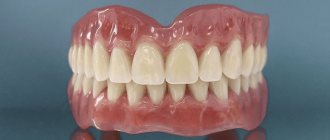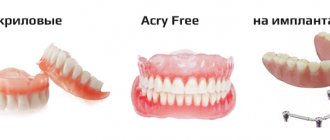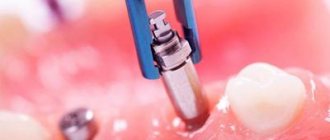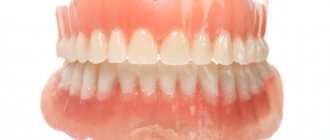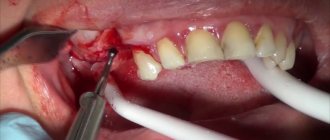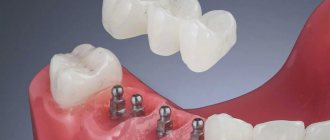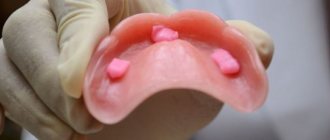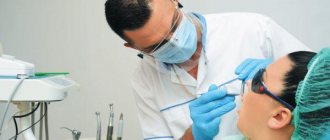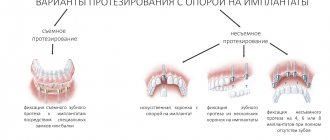How do covering dentures differ from removable dentures?
It’s easy to get confused in the concepts here, so let’s clarify that both types are removable. At least, that is what is commonly believed.
But in the classical view, coverings always have a strong support - teeth or implants. And traditional removable ones, especially with complete edentia, are fixed only on the gums. Although it is worth noting that in fact, even ordinary removable dentures have recently begun to be called overlays - this is argued by the fact that such structures also cover. Just not teeth or implants, but gums.
DENTAL PROSTHESIS ON 4 IMPLANTS - from RUR 170,000.
The price includes all procedures for installing Osstem implants (South Korea), including anesthesia and diagnostics.
Hurry up to sign up for a free consultation and fix your prices.
Call now or request a call
Opening hours: 24 hours a day - seven days a week
Advantages
- The ability to restore the dentition even with complete edentia on both jaws.
- The bar prosthesis is securely fixed with a locking connection on the bar, so there is no need to grab the gum. Thanks to this, the prosthesis is smaller and lighter than a traditional one, so it is more comfortable to wear and does not cause discomfort.
- Thanks to the beam, the chewing load is evenly distributed. There is no risk of injuring your gums, and there is no risk that the denture will move while eating.
- If necessary, the prosthesis can be easily replaced without harming the implants.
- Ease of daily oral and denture care.
- Minimal risk of bone tissue atrophy. Despite the fact that the prosthesis is fixed to several prostheses, they are connected to each other by a metal beam. The beam not only takes on the vertical load, but also distributes it evenly. As a result, the entire bone tissue is loaded, and not just at the implant site.
- More affordable cost of implantation and prosthetics. The bar prosthesis is fixed on 4-8 implants, which reduces the cost of the operation.
- Service life is about 10 years.
- Maintainability. If the prosthesis is damaged, it is easily replaced with a new one. Removing the bar does not affect the implants; they remain undamaged and a new prosthesis can be easily installed on them.
Covering dentures with fixation on the gums
This is the most famous and simplest type - the prosthesis is indicated for complete edentia (complete absence of teeth) and is attached only to the gums due to the “suction cup” effect. Such removable orthopedic structures take up a lot of space in the oral cavity - due to the massive artificial gum on the lower jaw and the palatal overlap on the upper jaw. Otherwise, they simply won't be able to resist.
Among the advantages are the lowest cost, almost complete absence of contraindications. The disadvantages are the following:
- very low comfort: nausea, gum chafing, blocked taste buds,
- poor fixation: displacement and falling out of the mouth, so there is a need to use a special “glue”, which does not always help,
- need for adjustments due to bone atrophy.
Bone atrophy deserves special mention. Areas of the jaw where there are no longer roots remain “idle.” And the bone, which does not receive chewing pressure, begins to atrophy (reduce in size in width and height). As a result, the gingival level decreases, and after a few months the removable “jaw” becomes uncomfortable - you will have to visit an orthopedist and have the structure repositioned.
Options include plate acrylic, Acry-free, nylon, polyurethane, Quattro Ti. You can read more about each variety by following the links.
Price of beam prosthetics
The cost of beam prosthetics is influenced by various factors, so it may vary even in the same clinic. Main factors:
- Type of implants. Implant systems can vary greatly in price. Our clinic uses different implants, and our orthopedist will choose the most suitable option for you.
- Number of implants. For complete edentia, at least 4 implants are required, for partial edentia, at least two. The smaller the number of implants, the cheaper the operation will cost.
- Additional dental procedures. In preparation for the operation, you will undergo a full diagnosis, treatment of identified dental problems, and sanitation of the oral cavity. The list of manipulations will influence the final price of beam prosthetics.
- Cost of beam and prosthesis.
Overdentures fixed to dental implants
Complete removable dental dentures require reliable and comfortable fixation, which is impossible if the structure is simply “sucked” to the gums. To do this, implants are installed on the dentition. The optimal quantity is 4 pieces for the upper jaw (here the bone is less dense) and 3-4 for the lower jaw. Some dentists install only 2 implants, but this number is not enough, because... the prosthesis does not hold very securely on them, and the implants are overloaded.
Implantologists recommend not placing all implants only in the anterior part of the jaw, if possible, but also using the lateral areas. This is optimal both from the point of view of distribution of the chewing load and the preservation of bone in the lateral areas.
%akc61%
A removable overdenture can be fixed to implants in different ways - on a spherical mount, on an equatorial type mount (Locator), on a beam. The covering orthopedic structure on implants is quite stable and it is not necessary to remove it every day. Therefore, dentists classify it not just as removable, but as conditionally removable prosthetics. Next, we will look in more detail at fixation methods.
"Push-button" fastening
On ball-shaped abutments
Ball mount is considered the simplest and most inexpensive option. In this case, in order to fix the overlay prosthesis, you need to place abutments on the implants (these are a kind of “adapters”) with a ball-shaped top. Special recesses are made in the prosthetic structure - matrices equipped with metal holders and silicone rings - when the patient installs the prosthesis, the matrix snaps onto the ball.
On equatorial type abutments
Equator-type or Locator abutments are also snapped into a silicone matrix, which is placed on the inside of the prosthetic base. However, the tops of the abutments are already presented in the form of cylinders with a seal on top, rather than balls. Therefore, their wear period, and, accordingly, their service life is longer.
As a rule, removable dentures on spherical and equatorial abutments are considered temporary options when the patient currently does not have the opportunity to undergo full implantation with fixed prosthetics.
Fixation on beam
A metal beam is the optimal way to fix a removable prosthetic structure on implants, because The chewing load is best distributed along the beam, which will then go to the implants and the jaw bone. The beam can be made by soldering or casting, but it is best milled using CAD/CAM systems (it is the most accurate). It is attached on top of the implants, uniting them like a bridge. And then a partial or full covering prosthesis is snapped onto the beam - there are special fasteners at its base, exactly in the shape of the beam.
Separately, it is worth highlighting non-removable dentures on implants - which the patient cannot remove on his own. Because they are fixed to the implants with small screws. But from the dentist’s point of view, this type will be conditionally removable, because The doctor himself can safely and quickly unscrew the screws and remove the structure - for example, for cleaning or repair. And then install it back. Such prosthetics are used with the very popular All-on-4 implantation technique.
Types of prosthetics for complete absence of teeth
In dental orthopedics, there are two options for complex prosthetics for total edentia: removable and fixed.
Fixed prosthetics
The Family Dentistry clinic performs daily rehabilitation operations for patients with complete absence of upper or lower teeth. We have performed more than 1,200 total jaw replacements.
All-on-4
A protocol for complex prosthetics, involving the installation of a fixed prosthesis with 10 or 12 crowns supported by four implants:
- two are implanted in parallel in the anterior section;
- two at an angle of up to 45° in the distal.
Why is inclined implantation of two implants used? Firstly, to increase the contact area between the bone and the implant (allows you to abandon the sinus lift). Secondly, in order to eliminate the risk of damage to the mandibular nerve or maxillary sinuses.
All-on-4 technology or “All-on-4” is a predictable and well-studied method of treating complete edentia (used since 1998) without bone grafting with good results in the short, medium and long term.
3-4 hours after installation of the implants or 3-7 days (often you need to wait for the swelling of the mucous membrane to go away after surgery), a temporary prosthesis is attached to the abutments.
After complete engraftment of titanium screws into the bone tissue (on average, this takes from 3 to 6 months), fixation is carried out with a permanent orthopedic structure.
All-on-6
A technique for complete jaw prosthetics for total edentia, developed on the basis of the All-on-4 protocol and being its logical, modified continuation.
To make it possible to use the technology in the rehabilitation of patients with a complex clinical picture (severe bone tissue atrophy, periodontitis/periodontal disease, diabetes mellitus, osteoporosis), six implants are used:
- two are fixed in the frontal zone;
- four – in the distal lateral section (two each on the right and left).
The use of a larger number of implants provides more reliable support for a fixed prosthesis (a bridge structure with a length of 14 crowns can be installed) and uniform distribution of the chewing load throughout the entire arch.
Covering dentures with fixation on your teeth
When several natural teeth are preserved, a removable overdenture is fixed on their crowns or roots. After examining the oral cavity, the dentist may suggest one of the following mounting options:
- on clasps or hooks that cover the supporting teeth on the sides without covering them completely. For example, an “immediate butterfly” for 1-2 teeth, a clasp with clasps, as well as those already mentioned above (for fixation on the gums) can also be equipped with clasps,
- on spherical attachments: attachments are locking fasteners and are installed on the tooth root. The upper part of the attachment is usually presented in the form of a miniature ball onto which the inner part of the covering prosthesis is fixed. The second part of the lock is located in the prosthetic base. Such fastening, for example, is found in a sandwich prosthesis,
- on telescopic crowns: the fastening is similar to the previous type, but here an artificial one is installed on the root or remains of your own crown - and a slightly larger crown is installed in the prosthesis. The two elements fit very tightly onto each other, so the structure can not be removed for several weeks. But in production, this type requires a very highly qualified dentist so that the crowns fit perfectly together.
Read on the topic: how telescopic crowns increase the comfort of life after prosthetics.
Design features
Consists of artificial gums and teeth. The main retaining components are locking fasteners located at the base of the removable segment and on the surface of the non-removable section of the combined structure. In complex clinical situations, magnetic clamps with additional mechanical devices are used - telescopic crowns, push-button/rail fasteners. Made from metal, acrylic, nylon. The process of prosthetics includes two stages: preparation of the preserved fragments/organs, during which the doctor fixes frame components in the root stump, and the actual manufacture of the product. When applying a finished restoration, the boundaries must be corrected and the quality of the closing valve must be checked.
Advantages of structures with fixation on roots or implants
The advantages of overlay prosthetic structures supported by teeth or implants are as follows:
- more reliable fixation in the oral cavity in comparison with classic removable ones, which are fixed only on the gums: attachment to remaining teeth or implants provides better stability and distribution of chewing pressure,
- do not rub gums,
- They are relatively small in size due to the absence of a massive palate or areas of artificial gum: therefore, the patient gets used to them faster, does not experience great difficulties with taste perception, and does not feel nausea,
- no need to use special adhesive creams,
- there is no need to build up the jaw bone before installing implants,
- pretty good aesthetics
- restoration of chewing function.
The advantages of covering structures “on buttons” are the low cost of tooth restoration. Implantation is low-traumatic - since mini-implants are often used. Also, the dental technician can modify the old overdenture for fixation on ball-shaped abutments, and the patient can continue to wear it.
Why is fixed prosthetics better than removable prosthetics?
Preventing bone atrophy With complete removable dentures, the main part of the chewing load is transferred to the mucous membranes, so bone tissue resorption begins. Implants function like real tooth roots. The chewing load is distributed onto the artificial teeth as if they were your own. Bone loss stops.
Reliable fixation A removable denture covering the entire jaw can fall out at any time. Fixed prosthetics on implants eliminates the risk of falling out. It eliminates the constant fear that the denture will fall out of the mouth at the most inopportune moment.
Preservation of taste/heat sensitivity A complete denture covers the palate. As a result, the taste and heat receptors of the oral cavity do not work.
Full restoration of chewing function A complete removable denture restores the chewing ability of the dentition by only 20-30%.
Disadvantages of structures with fixation on roots or implants
Coverings that rely on natural roots always run the risk of overloading or poor-quality preparation of supporting teeth for prosthetics. Therefore, after 5-7 years they often have to be removed.
“About a year after the prosthetics, my artificial jaw began to wobble a little. The dentist said that this is due to the fact that the load is large and the bone is dissolving around the roots. In general, as I understand, everything will only get worse, and the roots will have to be removed in a few years. In the meantime, the doctor advised us to strengthen our hygiene and try not to chew hard.”
Maria Vasilievna, review from the site irecommend.ru
The disadvantages of conditionally removable prosthetics on implants include the short service life of mini-implants (about 3 years). Disadvantages of beam fastening - it is impossible to adapt an old orthopedic design, and the cost of this solution is close to implantation on classical implants (which last for several decades) with the most reliable fixed prosthetics.
Installation options
The decision to use prosthetics is made after consultation and examination. The choice of the optimal method of carrying out the procedure depends on the current state of the prosthetic bed: the pliability of the mucous membrane, the degree of atrophy of the alveolar processes, the presence of bone protrusions, the shape and condition of single teeth/roots (quality of filling, absence/presence of convergence, response to tapping):
- on a natural frame. When installing a covering prosthesis, rational use of the remaining living elements should be a priority. To preserve them, the following are practiced: amputation (removal of one branch of a multi-root unit) and separation (dissection of the tooth into segments in the inflammatory area). This allows the roots to be used as the basis for restoration. An additional plus: the vertical transmission of pressure during chewing reduces the load on the mucous membrane, without causing a feeling of discomfort and shortening the adaptation period;
- on implants. For jaw prosthetics without teeth, their use is considered the best and most accessible method, due to the high percentage of clinical success, aesthetic effect and improved quality of life and chewing. Planning of orthopedic/surgical treatment protocols using this technique should take place after a thorough X-ray diagnosis in order to minimize the risks of postoperative complications and rejection of artificial frames.
Materials for the manufacture of structures
Now dentists have an impressive arsenal for the manufacture of all types of orthopedic structures. Covers can be made from the following materials:
- for the manufacture of artificial gums and prosthetic bases, acrylic is used (can cause irritation of mucous membranes), hypoallergenic monomer-free Acry-free, durable acrylic reinforced with diamond chips, polyurethane, nylon (very flexible and aesthetic, but stretches over time and cannot be repaired), Dental D" for Quattro Ti,
- metal and silicone are used for fastening elements: the most popular metal alloy is medical steel, but cobalt-chromium alloy (CHS), titanium,
- for artificial teeth: it can be acrylic, ceramics, metal-ceramics, metal-plastic, as well as zirconium dioxide (the most durable, but also the most expensive material).
Indications and contraindications
Indications for prosthetics are as follows:
- severe wear of natural crowns,
- complete destruction of the crowns, provided there are healthy roots (at least two of them must remain),
- the absence of many or all teeth in a row.
Contraindications to prosthetics on your own teeth are their mobility, the presence of cysts, granulomas, cracks and inflammation in the roots (the latter defect can be eliminated).
Contraindications to implantation are decompensated diabetes mellitus, serious pathologies of the endocrine cardiovascular system, recent heart attack, radiation or chemotherapy.
It is also impossible to install a prosthetic structure (removable or fixed) simultaneously on an implant and a natural tooth, because the latter has micromobility, but the implant does not.
What stages are included in prosthetics?
- Stage 1 – diagnosis: before implantation, tests are taken and a computed tomography scan of the jaw is performed. In other cases, doctors often make do with a targeted image, but CT is more informative,
- stage 2 – sanitation of the oral cavity: caries and pulpitis are treated here, the remaining roots are prepared, and ultrasonic air-abrasive cleaning is carried out. If necessary, the dentist cleans the gum pockets from pathological contents (this is called curettage). Also at this stage, you can do gingivotomy or gum surgery, frenuloplasty, remove diseased teeth,
- stage 3 – taking impressions and other parameters to create a model,
- stage 4 – implantation (if necessary): here the required number of implants is implanted,
- stage 5 – fitting and modification of the prosthesis,
- Stage 6 – final fixation of the finished product and training the patient in the rules of care.
Don't know what type of prosthetics to choose?
We will help in the selection, advise where to read more information and compare types of prosthetics.
Consultation with an orthopedic doctor in Moscow clinics is free! Call now or request a call
Working hours: from 9:00 to 21:00 - seven days a week
Stages
Before carrying out covering prosthetics, special preparation of the soft tissues of the oral cavity is necessary - periodontal pockets or parts of the mucous membrane are removed.
Stages of installation of a covering prosthesis:
- After a preliminary examination and sanitation of the oral cavity, impressions are taken from the lower and upper jaws with an alginate mass.
- Diagnostic models are made from durable plaster, on which the central occlusion and jaw relationship are determined.
- The dentist, together with the dental technician, analyzes diagnostic models and selects the design of the overdenture. If necessary, parallelometry of the alveolar ridge and teeth is performed.
- A temporary bare denture is made for use during the manufacture of a permanent one.
- The procedure for preparing abutment teeth is carried out in the dental office.
- Using silicone material, an impression of the jaws and prepared supporting teeth is taken.
- Based on the impression obtained, the dental technician creates a collapsible working model.
- The prepared wax composition is cast and then fitted onto the model.
- In the clinic, primary dental crowns are fitted on the supporting teeth.
- The dental technician creates a new model, which clearly shows the edges of the future covering prosthesis. Primary crowns are milled with carbide cutters and polished with fine diamond paste.
- A new working model is being prepared for duplication. A fireproof model is created from a special mass, on which a wax frame of the prosthesis is formed, and then cast.
- The cast frame is attached to the primary crowns, the outer telescopic crowns are polished from the inside with fine diamond paste, and the entire system is prepared for electric spark erosion.
- Electric spark erosion is performed using special equipment.
- The working model is placed in a spark erosion apparatus. After that, the dental technician fits the selected friction pins into the formed grooves and fixes them by contact welding.
- The clinic performs fitting of secondary crowns and removable denture frames.
- In the laboratory, secondary telescopic crowns are veneered, and the wax base is replaced with a plastic one.
- After installing the prosthesis, the occlusion is corrected and the primary crowns are fixed one by one with cement.
Features of using BPS technology
Let's first understand what BPS is? This is a biofunctional prosthetic system or Biofunctional Prosthetic System. Its meaning is that before making an overdenture, the parameters are taken using special devices to create an ideal bite and the relationship between the teeth on the upper and lower jaw. In the process of creating an orthopedic structure, an articulator, a face bow, and a Centric Tray impression tray from Ivoclar Vivadent are used. Several impressions are taken from the dentition, and parameters are assessed with the jaws closed and open. Also, the design model is tried on several times.
As a result, a product that is almost ideal in terms of comfort is created, which the patient practically does not feel in the mouth. The work of the temporomandibular joint is also normalized, the smile looks natural, and the face as a whole is harmonious.
Care instructions
Caring for overdentures on implants or on your own teeth is not much different - after eating, rinse your mouth with clean warm water or mouthwash. You can also use an irrigator, which very efficiently washes out food debris from the subprosthetic space. You need to brush your new teeth 2-3 times a day - it is better to buy a new brush, with soft bristles, and the toothpaste should not contain scratching abrasive particles.
For better cleansing, every 2-3 weeks you need to remove the orthopedic structure from your mouth - clean it from all sides, soak it in a special disinfectant solution. You should visit your dentist every 6 months for a check-up and professional cleaning.
Care of overdentures
An overdenture is a rather complex structure, so it requires proper care and strict adherence to oral hygiene.
It is necessary to clean the overdenture after each meal with special toothbrushes, pastes and gels. Twice a month you need to treat it with professional disinfectants.
Once every 2-3 months, visit the dentist’s office for preventive maintenance and professional hygienic cleaning.
Once a year, the product must be adjusted so that it does not cause discomfort, sits perfectly on the gums and tightly covers the palate. It may also be necessary to replace the fixing elements.
If damage is detected: chips, cracks or dents, or if the device begins to “slurp” in the mouth, pain and discomfort appear, you must contact a specialist to eliminate defects and adjust the design.
Compliance with the operating rules will help to avoid breakdowns, extend the life of the prosthesis and preserve the beauty of your smile for a long time.
Cost of covering orthopedic structures
Prices for overdentures vary greatly depending on the material, complexity of the work, and the need to install implants.
The most budget-friendly solution is made of acrylic with clasps, it costs about 15-20 thousand rubles for the restoration of one jaw. “Butterfly” costs from 6,500 rubles, clasp - from 40 thousand. Prosthetics on implants starts from 100 thousand - on spherical attachments, from 120 thousand rubles when fixed to a beam. And from 200 thousand, if the prosthesis is fixed with screws or cement, that is, it becomes irremovable. 1Zagorsky V.A. Partial removable and overlapping dentures, 2007.
